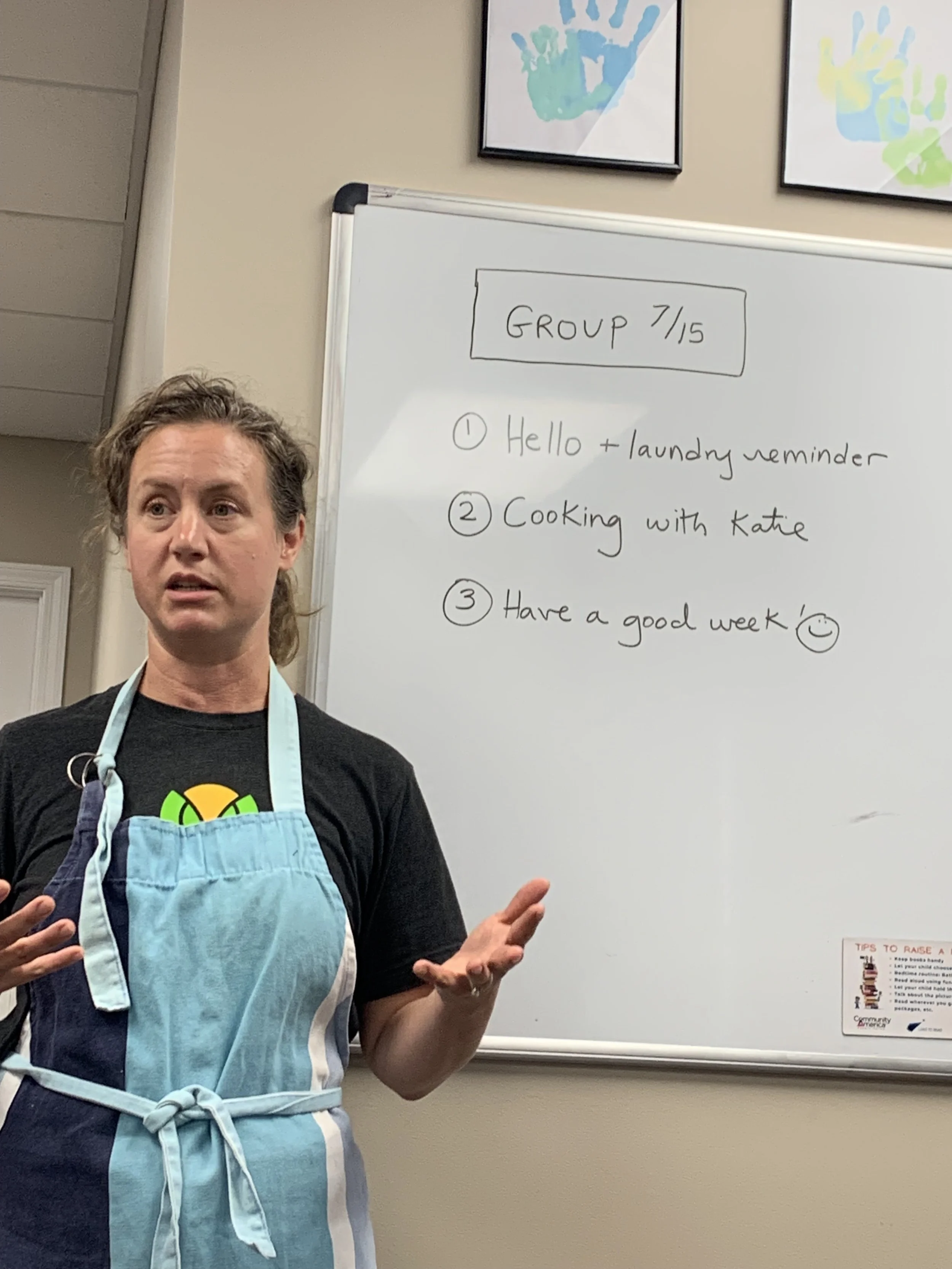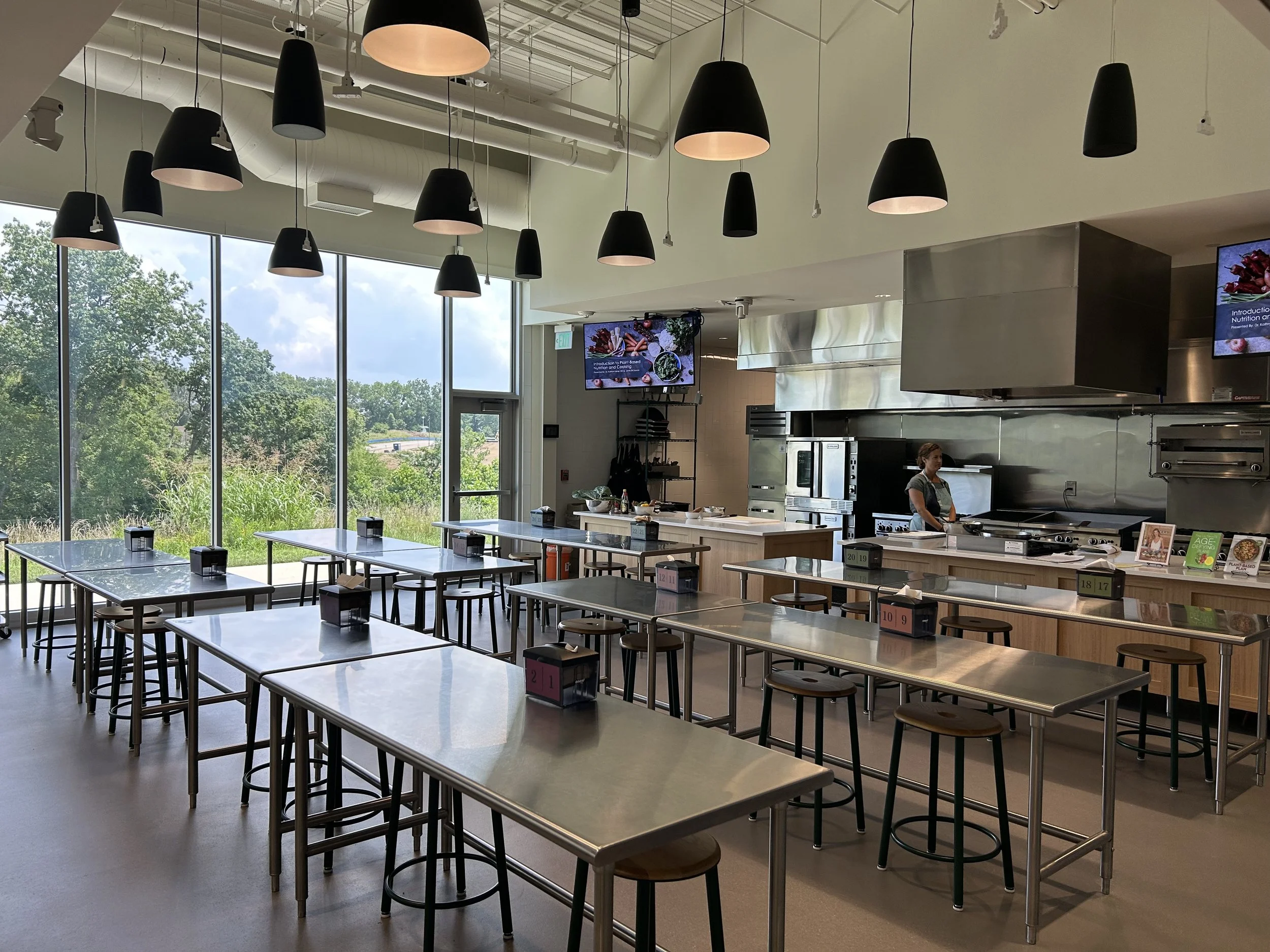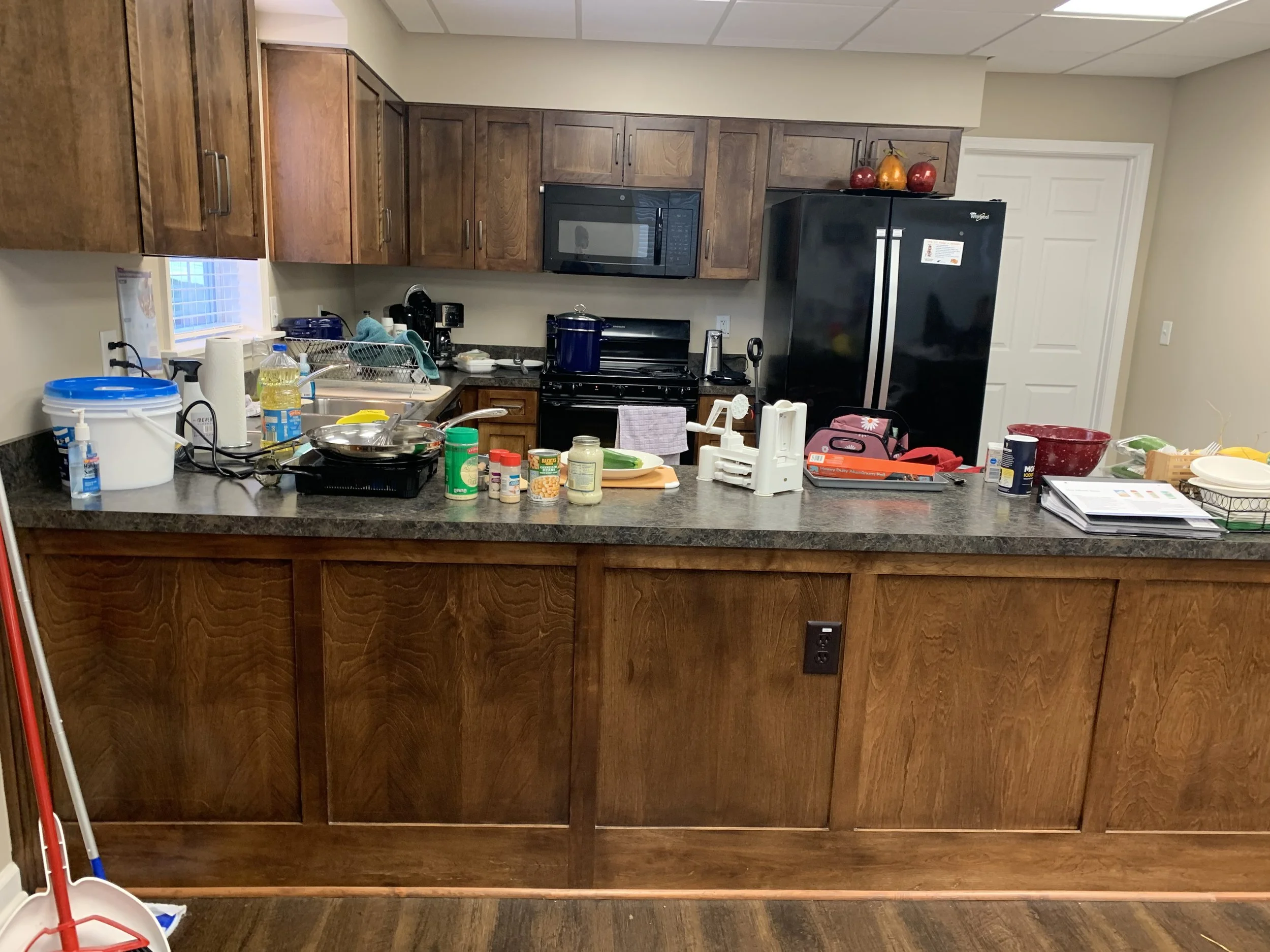Notes on teaching…
...Plant Based cooking classes to those in transitional housing using items from food pantries.
Over 3 year ago I set out to start teaching cooking classes for a transitional housing complex near me, one that my church supported. A representative from this complex came to meeting a group of us at church were having to discuss what the organization provided the community and the residents living there. He talked about having a food pantry and Life Skills classes for the residents. At the time, I wasn’t teaching any other classes, but had just earned my certification in Culinary Medicine. It would not be until 2024 that I would begin teaching cooking classes focused on Plant based eating.
My first classes were not at the transitional housing complex, but through one of my local libraries that happened to have a very new teaching kitchen along with more than one commercial kitchen space. The library system, being publicly supported, offered the classes for free to the public just like they offer books and other items free to borrow for the public that supports them. I told the library not to pay me, but they insisted. I still have these classes every so often, and have worked with a colleague who also focuses on plant-based eating. She is a wonderful resource for recipes and resources. These classes were great practice, but still only reached those with some average means.
So many places, the library included, were having cooking classes in retail spaces, kitchens set up outdoors, or even in kitchen purposefully built in clinics or hospital spaces to cater to the patient clientele. These all were newer and larger kitchens with all of the best equipment. Large countertops, multiple islands for participants to work from, color coded cutting boards, 6 burner gas ranges, convection ovens, warming drawers, three compartment stainless steel sinks, walk in fridge, a deep freeze, and drawers full of the smaller implements. Nothing like what most people who are not chefs or avid cooks have in their home kitchens. Nothing like what an average person would be able to afford. It looked very pretty and gave the presenter and participants everything they would need to learn to cook almost anything they wanted to.
But what about the average person, or the person coming from nothing? Someone who may have become accustomed to no kitchen, no fridge, no freezer, no way to heat up food or keep leftovers? Convenience of fast food and ultra processed food options, for all their demonization, are also a way those without skills or resources get calories. Some can only live day to day, or meal to meal, and have no way to save for the next meal by the time the first one ends. They are living on a timeline of hours, days, maybe weeks, while most of the rest of us live on timelines of months to years. Most housing insecure folks are also food insecure, but they are also not a monoculture. There is as much variability in the literacy of food as there is amongst any other social group of people. Sometimes it boils down to the access of food and space.
Still, as I have moved forward into the teaching kitchen and Culinary Medicine space, I have seen access built for the teaching of food literacy to accommodate those with a certain level of means. From private courses in the homes of participants and classes done in established teaching kitchens that pay out of pocket for the experience, to culinary centers in hospital systems catering to patients with insurance that will reimburse. Even high-quality virtual cooking classes come with a price, although can be varied, but also require a reliable internet and a comfort with remote learning. While all of these are well intentioned and give both the teaching and student a great sense of satisfaction, they are not meeting all.
The housing and food insecure are also more likely to lack health insurance and healthcare access due to this lack of insurance. Their health matters just as much if not more as poor health and the crisis that it can lead to will cost us more than them as we pick up the price tag for the care they can’t afford. They may need this kind of education more as it can have more impact. Not only can food literacy help with health, it can empower and give more choice. Not only can teaching kitchen and food safety and preparation be life skills, they can be built on to promote independence.
Most of us would agree that what we ingest, food and drink and medications, are all equally important to health. If food is on par with medications, then using it as an adjunct to medications for the treatment of disease and for the prevention of illness is a human right. I wrote more about this on my article “Food as Medicine needs a new name”. Should not the recommendation for dietary measures be for everyone? If two men, both 55 years old and both with Type 2 Diabetes, needed treatment, but one had health insurance and a primary care provider, and one was in transitional housing without insurance or a provider, should they not both get the equal care and services that could improve their health? If the insured man has access to a dietitian who also provides support through cooking classes, should not the uninsured man?
These were my thoughts as I looked at all the available options for people to engage in teaching kitchens and learn about healthy food, kitchen skills and safety, cooking various meals, and gaining basic knowledge regarding food’s role in our health. I did find that there were free classes for some, if they were already engaged in a research project, or if they were already part of a clinic’s cohort of patients. These classes still cost money for the systems they were a part of and came with other measurable factors. Classes like these, mostly through universities or public health organizations, are very important, as they allow us to learn how to improve access to food as medicine through various methods. The patient must be at the right place at the right time and be involved enough over a long timeline.
Still, for those with the most to gain, I didn’t see options. So, I made my own starting with my local transitional housing complex, their food pantry, and my time. It took some back and forth to get started, but after just one class, it became routine both for me and the participants.
Learning from my participant base was just as much a prerogative to me as the content I was providing. I initially made this a common statement in my classes to this group, and to similar groups as well. Later, I experimented with surveys to gain more knowledge, starting with validated ones used in research. I quickly moved on to more personalized surveys as the validated ones didn’t give me insight into those I was serving, and there was not anything gained that would help improve my content or the presentation or it. The personalized surveys gave me better awareness of where my participants stood on the food literacy scale, what objectives they had when it came to cooking and food, where they shopped, and how much they spent. This continues to evolve and has given me understanding of the needs of those that attend. My assumptions have been supplanted by facts, some not in line with my original thinking.
The first class was a total home run from my perspective, a success in that people attended and paid attention, food was used from the pantry to make a complete meal, and this meal was eaten by all. The level of politeness and attention was a true grace to me venturing out into this unknown space. There was a spectrum of vigor when it came to eating, some sampled and some came for seconds. A few volunteered to help, one taught me a valuable lesson in utilizing food pantry items, and one mentioned she thought I was crazy at first, but she quickly changed her mind.
I turned up at the complex where the first class was to be held almost 2 hours ahead of time. Leaving time to think and prepare, go home for a forgotten item, run to the store in case what I thought would be available wasn’t (I toured the pantry a few days before class to see what was in abundance.), and just think of something to make on the fly. I met the evening caretakers who later would give me some very good constructive criticism. Luckily, I didn’t have to make a run anyway for an item in need, I spent the time thinking of the meal and going over my steps of preparation of it.
Fresh oranges, some ginger and garlic powders, soy sauce, and peanut butter to make an Asian sauce. Spaghetti, frozen vegetables, and a can of Great Northern beans for the rest. I had found a lack of flavorings in the pantry when I toured it initially, so as I took pantry items to help make the meal, I equaled the loss with providing spices and sauces to help make meals out of otherwise bland pantry non-perishables. Buying these items is now my main grocery donation for all classes in all food pantry spaces.
The day of my first class, a bunch of fresh oranges were close to being a bit too soft or a bit too hard and so needed to be highlighted in the recipe and used. I try and tour the pantry or ask what is fresh a day or two ahead of the class. There are periods of time in which a grocery store has too much of something over a course of weeks. This makes for a pantry fridge stocked with a usable but overabundant item and puts that food item at risk of underuse and spoilage. Sometimes the pantry fridge is purged of hundreds of dollars of fresh food because the utilization of the overabundant food item can’t be used in time, there is not enough opportunity to use the food item, or lack of knowledge of how to use it. Mushrooms are a great example. For weeks there were mushrooms stocked in the pantry fridge, donated by a local grocery store on a regular basis. Mushrooms then made it to the cooking class recipe index as a ragu sauce, taco filling, or part of a fried rice dish.
The sauce recipe, “Nutty Sauce”, as well as most of the other food pantry class recipes can be found on the Cooking Classes page of this site. Food pantry recipes can be unconventional. This is because there are limited ingredients, and substitutions or deletions usually are mandatory. They also use limited kitchen equipment and are quick. This might not be the cuisine all are accustomed to or would like as an eating pattern for life. It can be a bridge towards the empowerment that comes with cooking for oneself and family, making more out of less, and being scrappy during lean times.
The participant that ate two helpings and the one that called me crazy were not the same person, but they could have been. The participant who ate two stopped me from taking a can opener to the can of beans before I washed it off. Food pantries are pretty good about making sure the food available is not expired or damaged or inedible. Many will have a volunteer write the expirations date on the top of the can with a dark Sharpie making the consumer aware of what is going to expire first as some non-perishable foods can live in the food pantry for quite a while. Cans can sit for months gathering dust. This just isn’t the reality for those of us in home with our own pantries filled with food we probably will eat soon enough. Also, most home pantries are not open to the indoor elements brought in by multiple persons walking in and out. Those who have experienced homelessness, I have witnessed, can be very particular about sanitation. A dry cornflake that fell out of the bowl onto a clean counter is not edible. A packet of sugar on top of the bowl of dried cornflakes is now not a bowl of food to eat. A can of food I have not cleaned off thoroughly in front of the group is not to be used. My theory is that when the public domain is your space, sanitation is seen differently than it would be in a home environment where one can get accustomed to other levels of cleanliness.
For the participant who called me crazy, they had to have time to contemplate the marriage of orange juice, soy sauce, and peanut butter. They were coming from a world where these three things are divided so hugely, to put them together seemed as illogically as opening the uncleaned can. They accepted that their mind was changed, laughed at it, and left happy. I took this as a sign of increased choice leading to empowerment and independence. When any of us learn something new, a new way of doing something, or a new way understanding, we are given new choices. These new choices can then open the door to better decisions and a freedom to decide destiny. One thing that leads to people making poor decisions, or doing harmful or illegal things, is that they lacked choices. Most people are making their best decisions from amongst the choices they have now with the knowledge, skills, and insight granted them. We do it every day but must realize that we all have different choices and are using different knowledge, skills, and insight than even the person to our right and to our left. Those who seem to only eat fast food and ultra processed food usually only have the choice to eat this way. They may only have the knowledge of that kind of food as an option. They may lack the skills to make better choices or may lack the insight into food choices and health.
Of course, as stated in the beginning, those who are housing and food insecure also have various degrees of knowledge, skills, and insight. From my most recent surveys, some simply lack the sense of pleasure or enjoyment that can come from cooking. Another is that cooking is seen as one more mandatory activity of a household, like cleaning the toilet or doing laundry. It is done daily, and there is so much also to do, getting meals out and eaten as efficiently as possible is a big priority. So how to elevate cooking and making healthy meals to a level on par with watching TV, playing games with the kids, or just relaxing? This in a space that may not be conducive to meal prepping, having loads of fresh ingredients, or keeping leftovers. This is a challenge I have on my radar to read and write more about. See “Good Intentions at 8am.”
Since the jump into voluntary Plant-based cooking classes at one complex last year, I have added another, started a Substack and this website in hopes of gaining ground in my outreach and self-education on the needs of those we often do not see. There are other groups of people we don’t often think about or see that have more to gain from food and health literacy. I wish this were more of a movement, but for now I am happy for this read.
Thanks


